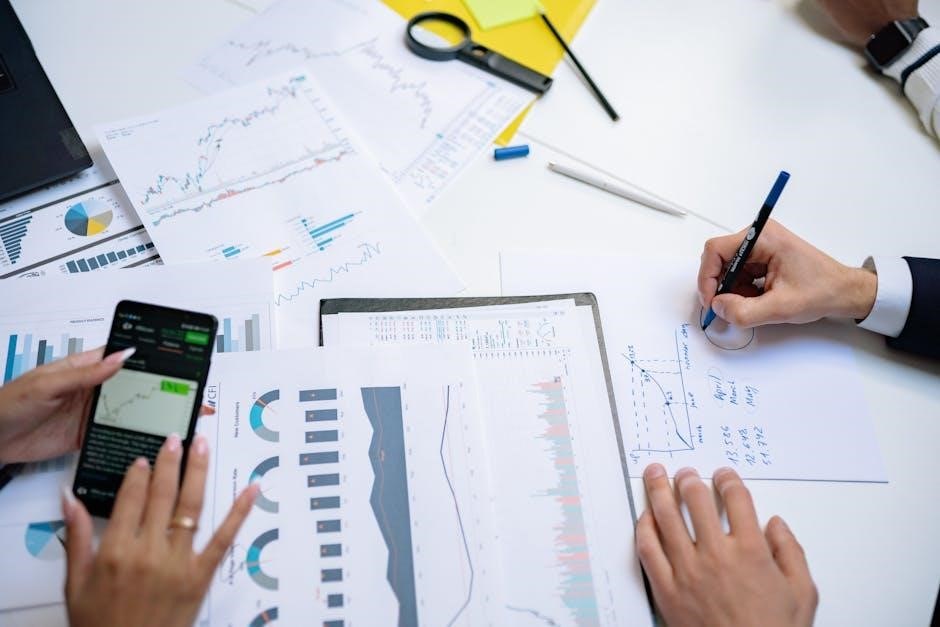Applied statistics empowers businesses and economists to make data-driven decisions, solving real-world problems efficiently. Textbooks like Applied Statistics in Business and Economics by Doane offer practical insights and tools for analyzing economic data, emphasizing real-world applications and accessibility for learners.
1.1 Overview of Applied Statistics
Applied statistics involves the practical application of statistical methods to solve real-world problems in business and economics. It focuses on data collection, analysis, and interpretation to inform decision-making. This field combines descriptive and inferential statistics to understand trends, forecast outcomes, and optimize processes. Resources like the Applied Statistics in Business and Economics PDF provide comprehensive guides, covering tools and software such as Excel, R, and SPSS. These materials emphasize accessibility, offering clear explanations for learners. By bridging theory and practice, applied statistics enables professionals to leverage data effectively, driving efficiency and innovation in economic and business contexts.
1.2 Importance of Statistics in Business Decision-Making
Statistics plays a pivotal role in business decision-making by enabling data-driven insights. It helps organizations analyze market trends, customer behavior, and operational efficiency. Through statistical methods like regression analysis and hypothesis testing, businesses can forecast sales, manage risks, and optimize resources. The Applied Statistics in Business and Economics PDF highlights how these techniques empower leaders to make informed choices. By leveraging statistical tools, companies can identify opportunities, mitigate challenges, and achieve sustainable growth. This data-centric approach fosters innovation and ensures that strategic decisions align with business objectives, driving long-term success and competitiveness in dynamic markets.
1.3 Evolution of Statistical Applications in Economics
The application of statistics in economics has evolved significantly, from basic descriptive methods to advanced econometric modeling. Early practices focused on understanding economic indicators, while modern approaches incorporate machine learning and big data. Textbooks like Applied Statistics in Business and Economics highlight this progression, emphasizing the role of tools like SPSS and R in analyzing economic trends. As data complexity grows, statistical techniques have become more sophisticated, enabling precise forecasting and policy-making. This evolution underscores the critical role of statistics in addressing economic challenges and driving evidence-based decision-making in both academic and real-world contexts.

Key Concepts in Applied Statistics
Applied statistics involves essential concepts like descriptive statistics, inferential statistics, and probability distributions. These tools enable businesses to analyze data, make informed decisions, and predict future trends effectively.
2.1 Descriptive Statistics in Business Contexts
Descriptive statistics provides a summary of data to understand key characteristics. In business, it involves calculating measures like mean, median, mode, and standard deviation to analyze performance metrics. Companies use these tools to summarize sales data, customer demographics, or operational efficiency. Visual representations, such as charts and graphs, help in presenting insights clearly. Descriptive statistics also identifies trends and patterns, enabling businesses to make informed decisions. For example, it can reveal customer purchasing habits or production bottlenecks, offering a foundation for further analysis.
2.2 Inferential Statistics for Economic Analysis
Inferential statistics enables economists to draw conclusions about a population based on sample data. Techniques like hypothesis testing and confidence intervals are widely used to analyze economic trends and validate theories. For instance, economists might test hypotheses about GDP growth or unemployment rates. Inferential methods also help estimate population parameters, such as average income levels or market demand. These tools are essential for predicting future economic conditions and informing policy decisions. By extending insights beyond the data at hand, inferential statistics supports evidence-based strategies in both business and economic contexts.
2.3 Probability Distributions and Their Applications
Probability distributions are fundamental tools in applied statistics, describing the likelihood of outcomes in a dataset. Common distributions include the normal distribution, binomial distribution, and Poisson distribution. These distributions help model real-world phenomena, such as market demand, investment returns, or economic events. In business, they are used for risk assessment, forecasting, and quality control. For example, the normal distribution can model stock prices, while the binomial distribution can predict customer churn. Understanding probability distributions enables economists and managers to make informed decisions under uncertainty, enhancing strategic planning and operational efficiency in various industries.

Statistical Tools and Software
Statistical tools and software, like Excel, R, and SPSS, are essential for data analysis, enabling businesses to make informed decisions through advanced modeling and visualization techniques.
3.1 Microsoft Excel for Data Analysis
Microsoft Excel is a widely used tool for statistical analysis in business and economics. It offers functions for descriptive statistics, such as mean, median, and standard deviation, and data visualization through charts and graphs. Excel’s Data Analysis ToolPak provides advanced features like regression, hypothesis testing, and ANOVA. Its user-friendly interface makes it accessible for professionals to perform quick data analysis, create forecasts, and present insights effectively. Excel is particularly useful for small to medium-sized datasets and is often integrated into broader statistical workflows for its versatility and compatibility with other tools.
3.2 R Programming in Business Statistics
R programming is a powerful tool for applied statistics, offering extensive libraries for data analysis. Its flexibility in handling complex datasets makes it ideal for business applications. With libraries like dplyr and tidyr, R excels in data manipulation and visualization. It supports advanced techniques such as regression analysis, hypothesis testing, and predictive modeling. R’s ggplot2 library enables creation of detailed visualizations, aiding in presenting statistical insights. Its open-source nature and active community ensure constant updates, making R a preferred choice for both academia and industry, especially for tasks requiring customization and precision in statistical analysis.
3.3 SPSS and Its Role in Economic Research
SPSS is a statistical software widely used in economic research for data analysis and interpretation. It offers advanced tools for managing and analyzing large datasets, making it essential for economists. SPSS supports various statistical techniques, including regression analysis, hypothesis testing, and predictive modeling. Its user-friendly interface allows researchers to perform complex analyses efficiently. Additionally, SPSS enables data visualization, helping economists present insights clearly. It is particularly valuable in policy-making, as it aids in forecasting economic trends and evaluating the impact of policy interventions. SPSS remains a cornerstone in applied statistics, supporting evidence-based decision-making in economic research and business strategy development.

Real-World Applications of Applied Statistics
Applied statistics drives decision-making in business and economics through market research, financial forecasting, and operational optimization, enabling data-driven strategies and competitive advantages in dynamic environments.
4.1 Market Research and Consumer Behavior Analysis
In business, applied statistics is crucial for understanding consumer behavior and market trends. Companies use statistical methods to analyze customer preferences, purchasing patterns, and demographic data. Tools like surveys, focus groups, and transactional data provide insights, enabling businesses to tailor products and marketing strategies. Descriptive statistics summarize data, while inferential statistics predict trends. Techniques like regression analysis and clustering help identify target segments. This data-driven approach enhances decision-making, optimizes resource allocation, and improves customer satisfaction. By leveraging statistics, firms can anticipate market shifts and stay competitive in dynamic environments, ultimately driving growth and profitability through informed strategies.
4.2 Financial Analysis and Risk Management
Applied statistics is integral to financial analysis and risk management, offering methods to interpret financial data and predict market trends. Techniques like regression analysis and time series forecasting are vital for assessing risks and making informed decisions. Statistical models help identify and mitigate financial risks, ensuring stability in volatile markets. These tools enable businesses to optimize portfolios and maintain economic stability through data-driven strategies, ultimately supporting informed decision-making and fostering a secure financial environment.
4.3 Operational Efficiency in Supply Chain Management
Applied statistics significantly enhances operational efficiency in supply chain management by optimizing processes and improving decision-making. Statistical tools like demand forecasting and inventory optimization enable businesses to align supply with demand, reducing costs and lead times. Analytical methods such as regression analysis and simulation modeling help identify bottlenecks and improve resource allocation. By leveraging data-driven insights, companies can streamline logistics, enhance customer satisfaction, and achieve sustainable operational improvements, ensuring a competitive edge in dynamic markets.

Economic Forecasting and Modeling
Economic forecasting and modeling use applied statistics to predict market trends, enabling businesses to make informed decisions and strategize effectively for future economic conditions.
5.1 Time Series Analysis for Economic Predictions

Time series analysis is a statistical method used to forecast future economic trends by examining historical data. It identifies patterns, trends, and seasonal variations, enabling accurate predictions. Techniques like moving averages and exponential smoothing are commonly applied; This approach helps businesses and policymakers anticipate economic fluctuations, such as GDP growth or inflation rates. By leveraging time series models, organizations can make informed decisions to mitigate risks and capitalize on opportunities. Accurate forecasting enhances strategic planning and resource allocation, ensuring sustainable growth in dynamic economic environments. Time series analysis is indispensable for understanding and predicting economic cycles effectively.
5.2 Regression Analysis in Business Forecasting
Regression analysis is a powerful statistical tool for predicting business outcomes by establishing relationships between variables. It helps organizations forecast sales, revenue, and market trends by analyzing historical data. Linear and multiple regression models are commonly used to identify factors influencing business performance. For instance, a company can use regression to predict future sales based on historical data, marketing efforts, and economic indicators. This method enables businesses to make data-driven decisions, optimize resource allocation, and improve strategic planning. Accurate forecasting with regression analysis is crucial for maintaining a competitive edge in dynamic markets.
5.3 Econometric Models for Policy Making
Econometric models are essential tools for policymakers to analyze the impact of economic policies. These models use statistical techniques to estimate relationships between variables, enabling predictions of policy outcomes. By incorporating historical data and theoretical frameworks, econometric models provide a robust framework for evaluating policy interventions. Policymakers can simulate scenarios to understand potential effects before implementation. This approach supports evidence-based decision-making and helps identify optimal policy interventions. Econometric models are crucial for designing policies that promote sustainable economic growth and development, ensuring that decisions are grounded in data and rigorous analysis.

Case Studies in Business and Economics
Case studies demonstrate real-world applications of applied statistics, showcasing how data analysis solves business and economic challenges, providing practical insights for informed decision-making.
6.1 Statistical Analysis in Marketing Strategies
Statistical analysis plays a pivotal role in shaping marketing strategies by providing insights into consumer behavior, preferences, and market trends. Businesses leverage tools like regression analysis and clustering to segment audiences and tailor campaigns. Data visualization techniques, such as charts and heatmaps, help marketers interpret complex datasets. For instance, A/B testing is widely used to determine the effectiveness of different marketing approaches. By applying statistical methods, companies can optimize their strategies, enhance customer engagement, and improve ROI. These techniques enable data-driven decision-making, ensuring alignment with business goals and competitive market demands. Real-world examples highlight the transformative impact of statistics in modern marketing practices.
6.2 Economic Impact Analysis of Policy Decisions
Statistical methods are essential for evaluating the economic impact of policy decisions, enabling policymakers to anticipate outcomes and make informed choices. Techniques like cost-benefit analysis and econometric modeling help quantify the effects of policies on GDP, employment, and inflation. By analyzing historical data and simulating scenarios, statisticians can predict how policy changes might influence economic indicators. This approach ensures that decisions are grounded in empirical evidence, reducing uncertainty and fostering sustainable economic growth. Applied statistics also aids in identifying unintended consequences, allowing for adjustments that align policies with broader economic objectives and stakeholder expectations. Real-world applications demonstrate its critical role in shaping effective policy frameworks.
6.3 Data-Driven Decision Making in Finance
Applied statistics plays a pivotal role in finance by enabling data-driven decision-making; Financial institutions leverage statistical tools to analyze market trends, assess risks, and predict future outcomes. Techniques like regression analysis and time series forecasting help in evaluating investment opportunities and portfolio performance. Statistical models also aid in identifying fraudulent transactions and managing operational risks. By relying on data insights, businesses can optimize resource allocation, enhance profitability, and maintain competitive advantages. This approach ensures that financial decisions are grounded in objective data, fostering reliability and long-term sustainability in an increasingly complex economic landscape.

Learning Resources and Textbooks
Essential textbooks and resources provide foundational knowledge, practical examples, and advanced techniques in applied statistics for business and economics, aiding learners in mastering data analysis and interpretation skills.
7.1 “Applied Statistics in Business and Economics” by Doane
This textbook by David P. Doane provides a comprehensive introduction to applied statistics, tailored for business and economics. It emphasizes practical applications, real-world examples, and clear explanations of statistical concepts. The book covers essential topics like descriptive statistics, probability, and inferential statistics, with a focus on business contexts. Students and professionals alike benefit from its accessible language and hands-on approach. Available in PDF format, it includes exercises, case studies, and visual aids to enhance learning. Supplementary materials, such as workbooks and online resources, further support mastery of statistical techniques.
7.2 Study Guides and Companion Materials
Study guides and companion materials are invaluable resources for mastering applied statistics in business and economics. These supplements often include step-by-step solutions, practice problems, and additional examples that complement textbooks. They help reinforce concepts like regression analysis, hypothesis testing, and data visualization. Many guides are available in PDF format, making them accessible for digital learners. Companion materials may also offer interactive exercises, quizzes, and datasets for hands-on practice. These tools are designed to enhance understanding and application of statistical methods in real-world business scenarios, ensuring learners can apply their knowledge effectively. They are essential for both students and professionals seeking to deepen their skills.
7.3 Online Courses for Applied Statistics
Online courses offer flexible and comprehensive learning opportunities in applied statistics, tailored for business and economics. Platforms like Coursera, edX, and Udemy provide courses that cover essential topics such as data analysis, statistical modeling, and data visualization. Many courses include interactive labs, real-world case studies, and downloadable resources, including PDF materials. These programs cater to various skill levels, from beginners to advanced learners. Certifications upon completion enhance professional credentials. Online courses enable learners to apply statistical knowledge to business challenges, making them a valuable resource for both academic and professional development in applied statistics.

Ethical Considerations in Statistical Analysis
Ethical statistical analysis ensures transparency, objectivity, and accountability in data interpretation, avoiding misleading conclusions that could harm businesses or economies.
8.1 Data Privacy and Confidentiality
Data privacy and confidentiality are critical in applied statistics, ensuring sensitive business and economic information is protected from unauthorized access or misuse. Ethical practices mandate securely handling datasets to prevent breaches, safeguarding personal and proprietary data. Compliance with regulations like GDPR is essential to avoid legal repercussions and maintain trust. Anonymization and encryption are key tools for protecting identities while allowing statistical analysis. Organizations must adopt robust policies to govern data access and usage, ensuring transparency in how information is collected, stored, and analyzed. Breaches can lead to financial loss and reputational damage, emphasizing the need for stringent controls.
8.2 Avoiding Bias in Statistical Reporting
Avoiding bias in statistical reporting is essential for maintaining credibility and accuracy in business and economic analysis. Bias can arise from sampling methods, data collection practices, or interpretation techniques, leading to misleading conclusions. To mitigate this, analysts should employ random sampling, ensure diverse data representation, and clearly document methodologies. Transparency in reporting limitations and assumptions is also crucial. Regular peer reviews and adherence to ethical guidelines help minimize subjective interpretations. By addressing potential biases proactively, organizations can ensure their statistical reports are reliable and free from undue influence, fostering better decision-making and trust among stakeholders.
8.3 Ethical Implications of Data Interpretation
Ethical considerations in data interpretation are critical to ensure responsible use of statistical insights in business and economics. Misinterpretation or manipulation of data can lead to misleading conclusions, potentially harming stakeholders; Ethical analysts must prioritize transparency, objectivity, and accountability. This includes avoiding cherry-picking data, clearly presenting limitations, and being mindful of cultural and societal sensitivities. Additionally, interpreters should communicate findings in an unbiased manner, avoiding oversimplification. Ethical practices foster trust and integrity, ensuring that data-driven decisions align with organizational values and societal expectations. Upholding these standards is vital for sustainable and equitable outcomes in business and economic applications.

Future Trends in Applied Statistics
Future trends include integrating big data analytics, AI, and machine learning, enabling predictive modeling and real-time decision-making in business and economics. Sustainability focus is growing.
9.1 Big Data Analytics in Business
Big data analytics is revolutionizing business decision-making by processing vast amounts of structured and unstructured data. Companies leverage tools like Hadoop and Spark to analyze large datasets, uncovering patterns and insights. This enables predictive analytics, customer segmentation, and real-time monitoring. In retail, big data optimizes inventory and personalizes marketing. In finance, it detects fraud and manages risks. The integration of machine learning enhances accuracy, while cloud computing ensures scalability. As data grows, businesses must invest in skilled professionals to interpret and act on insights, driving innovation and competitive advantage in a data-driven economy.
9.2 Artificial Intelligence and Machine Learning
Artificial intelligence (AI) and machine learning (ML) are transforming applied statistics in business and economics. These technologies automate data analysis, enabling predictive modeling and real-time decision-making. ML algorithms, such as neural networks and decision trees, uncover complex patterns in data, improving forecast accuracy. Businesses use AI for customer segmentation, demand prediction, and process optimization. ML also enhances risk assessment and fraud detection. By integrating statistical techniques with AI, organizations gain deeper insights, fostering innovation and efficiency. The synergy between statistics and AI drives smarter, data-driven strategies, reshaping industries and economic landscapes.
9.3 Sustainability and Green Economics
Sustainability and green economics are increasingly vital in applied statistics, focusing on reducing environmental impact while promoting economic growth. Statistical methods help measure carbon footprints, optimize resource use, and evaluate renewable energy efficiency. Businesses use statistical models to assess sustainability initiatives, ensuring they meet environmental and profitability goals. Governments rely on statistical analysis to design policies and monitor progress toward climate targets. Applied statistics also aids in identifying green investment opportunities and evaluating the effectiveness of sustainability programs. By integrating data-driven insights, organizations can balance economic development with environmental preservation, fostering a sustainable future.
Applied statistics is a cornerstone of informed decision-making in business and economics, offering tools to analyze data, forecast trends, and drive sustainable growth. Further study is encouraged.
10.1 Summary of Key Takeaways
Applied statistics plays a pivotal role in business and economics by enabling data-driven decision-making. Key concepts like descriptive and inferential statistics provide insights into data analysis. Tools such as Excel, R, and SPSS are essential for practical applications. Real-world uses include market research, financial risk management, and operational efficiency. Forecasting methods like regression and time series analysis help predict economic trends. Case studies highlight the impact of statistical methods in marketing, policy, and finance. Ethical considerations emphasize data privacy and bias avoidance. Future trends include big data, AI, and sustainability. Continuous learning is crucial to leverage these advancements effectively.
10.2 Encouragement for Further Study
Applied statistics is a dynamic field, offering immense potential for professionals in business and economics. To deepen your expertise, explore advanced topics like machine learning and econometric modeling. Pursue specialized courses or certifications in data analytics and statistical software. Leveraging resources like textbooks and online platforms can enhance your skills. Practicing real-world problems and staying updated with industry trends will further solidify your understanding. Continuous learning ensures adaptability in a data-driven world, unlocking opportunities for innovation and leadership in your career.





